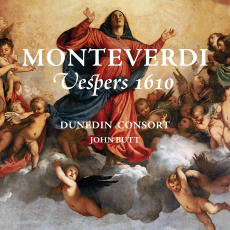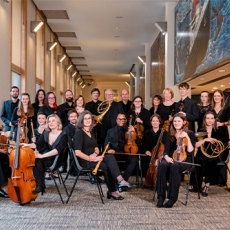Dunedin Consort - Monteverdi: Vespers 1610 - Early Music Review
As an admirer of John Butt’s performances of Bach’s choral works, I approached his new recording of Monteverdi’s 1610 Vespers settings with considerable interest and anticipation. That the results seem to me less satisfying than his Bach is probably down to my conclusions falling mostly into the realms of subjective observations rather than outright criticism.
Readers familiar with Butt’s one-per-part Bach will not be surprised to learn that he adopts a similar policy with Vespers. That is to say a single voice is allotted to each of Monteverdi’s two 5-part vocal choirs, making a total of ten singers, all of whom are employed in the works marked for voices and substantial instrument forces such as the opening 6-part ‘Deus in adiutorium’ or all ten voices like ‘Nisi Dominus’, scored for two 5-part choirs and continuo. Given the outstandingly tuned singing and ensemble, the result is to expose Monteverdi’s often dazzling counterpoint in rare detail and clarity, especially given some slower than usual tempos, a topic to which I’ll return. There are, however, some unconvincing solutions, in particular Butt’s odd decision to allot both his sopranos (Joanne Lunn and Esther Brazil) to the ‘Sonata sopra Sancta Maria’, which is clearly marked Cantus in the King’s Music score he employs and obviously intended for a solo soprano. It doesn’t work with two singers, especially given that the diction is poor.
Other practical points. Given that there is no record of a complete performance in Monteverdi’s time Butt has not attempted to place the Monteverdi’s psalm settings in a liturgical context. Although considerable controversy surrounds questions of performance practice in relation to the 1610 Vespers, it now seems generally accepted that the pitch should be something in excess of standard modern pitch A=440, Butt choosing A=466, a semi-tone above. That works well with the high clefs (‘chiavette’) of ‘Lauda Jerusalem’ and Magnificat, their 4th downward transposition now accepted by most scholars. Perhaps more controversial will be Butt’s use of proportional tempos within the larger two-part tactus beat, especially as it appears to account for some of the slow tempos mentioned above. I felt especially aware of this in ‘Audi coelum’ (over which Butt takes 9:17 as against the 7:30 of Andrew Parrott in his path-breaking 1984 EMI recording) and hymn setting ‘Ave Maris Stella’, which to my mind drags. Elsewhere Butt’s use of tactus allows a flexibility that can work extremely well, as in ‘Nigra sum’, splendidly sung by Nicholas Mulroy with great intensity, and ‘Duo Seraphim’ for three tenors (Matthew Long, Joshua Ellicott and Mulroy), where the sense of wonder in the Trinity is most effectively evoked. It is in fact in the vocal concertos featuring male voices that the performance is for me at its most effective, since while the pure voices of sopranos in, say, ‘Pulchra es’ are beautifully produced, it is a virginal purity lacking any hint of the erotic that seems too Anglo-Saxon for this colourful Mediterranean music. This applies, too, to the larger-scale pieces, which sound just that touch too polite, too lacking that feeling of being on the edge that should be conveyed by this at times outrageously experimental music. The singing itself is invariably good, with ornamentation mostly capably executed, while the instrumental playing, which features the excellent His Majesties Sagbutts and Cornetts in addition to the Dunedin Consort is first rate. Although this is music that allows for considerable choice when it comes to continuo instruments, I’m not at all convinced by the harp in ‘Laetatus sum’.
To summarize it would be fair to say that I admire the performance more than I am excited by it. Others will surely disagree and no one should be in any doubt that it is a finely conceived and splendidly executed achievement.


